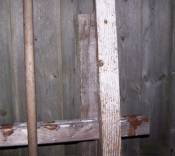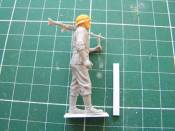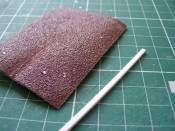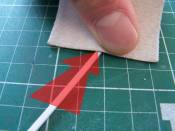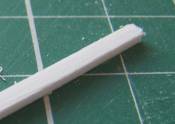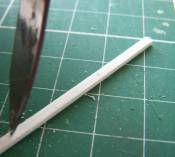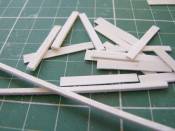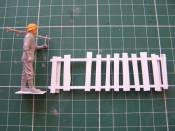1⁄35Make your own realistic wood
15
Comments
A lot of people who built diorama’s often want something for in the background or just an empty space to fill, This can be a fence between houses or on the border of a cattlefield. In a lot of cases it can be bigger structures too, think of a house, shed or barn… something with a more prominent role in the diorama. Sometimes it can be as small as a sign on the back of a tank as eyecatcher… the possibilities are endless
A lot of people are using balsawood for that kind of stuff, also popsicle sticks, matchsticks or the wooden stirring sticks you can stea……. borrow from the station. I too have used this for very long. The much used phrase “you can’t get better then what mother nature supplies you with” is still very true. The problem only is with most types of wood used in scalemodelling (My opinion) is that it exactly looks like what it is: 1:1 balsawood and often the structure is too rough.
The method I explain in this article will work for everybody. It is terribly easy and with not that much effort you can reach a very nice result. The big fun is that in the whole process not a splinter wood is used. Styrene is the medium.
- Styrene (I have used Evergreen but any styrene will do the trick)
- Xacto hobbyknife
- Sandingpaper with a heavy grit
- Glue (I used the UHU plast, purple bottle with a needle any plastic cement will do)
- Paint (In my case Humbrol )
First I started to make up the height of the fence. I almost never measure things out. I just decide by looking at it and comparing it next to a figure. If I have doubts later on I will measure it up and do some scale calculating if what I’m doing looks right and is right So I took a figure measured out two posts that were meant to go into the ground 2 beams that would go across and a bunch of planks out of thinner styrene
A lot of people are using balsawood for that kind of stuff, also popsicle sticks, matchsticks or the wooden stirring sticks you can stea……. borrow from the station. I too have used this for very long. The much used phrase “you can’t get better then what mother nature supplies you with” is still very true. The problem only is with most types of wood used in scalemodelling (My opinion) is that it exactly looks like what it is: 1:1 balsawood and often the structure is too rough.
The method I explain in this article will work for everybody. It is terribly easy and with not that much effort you can reach a very nice result. The big fun is that in the whole process not a splinter wood is used. Styrene is the medium.

Materials
Ok the next stuff you need to make wood out of plastic:- Styrene (I have used Evergreen but any styrene will do the trick)
- Xacto hobbyknife
- Sandingpaper with a heavy grit
- Glue (I used the UHU plast, purple bottle with a needle any plastic cement will do)
- Paint (In my case Humbrol )

Step1: “From thick styrene to planks”
Ok now we have all the needed materials we can start. For my article I have choosen to built a low type of fence which could be placed in a rural area along a field or a ditch. Not the kind of woodwork a carpenter would work on for hours to get it neat and tidy.. .just a fence that does his job instead of looking good.First I started to make up the height of the fence. I almost never measure things out. I just decide by looking at it and comparing it next to a figure. If I have doubts later on I will measure it up and do some scale calculating if what I’m doing looks right and is right So I took a figure measured out two posts that were meant to go into the ground 2 beams that would go across and a bunch of planks out of thinner styrene
Step 2 “Woodgrain”
Next step is making the woodgrain, Because styrene without woodgrain is just….. styrene and by far no wood. In the past I have used the scraping technique in which you use the hobbyknife to score the surface and making woodgrain in that way. Besides that it really takes ages to do the result is not really good. And the chance of ending up with your fingers in bandaid is also quite big. So I thought there should be an easier way of doing this and that is how I came to sandingpaper. I tried it and yes it definitely gave a very neat result. Although it gave me a good result the real power of the technique would show up in the painting stage. The fun is that it is fast and it will give you a very nice irregular woodgrain which shows a nice variation in depth. Also the softness of the Evergreen makes that you get the splintery appearance to the plastic whcih often shows up on rough wood. If you don´t want this effect just clean it with a little lighter sanding paper or scrape it away with your exacto To give more depth I also used the scraping method to make some deeper cracks in the woodStep 3 “Assemby”
Now we have all the parts ready for the fence we can start to assemble it. No fancy tricks here. Just glue it together. During this stage of the built you can decide about little changes in the design. Broken planks, loose planks etc. Here I added the borken plank which I made by making small cuts in teh length of the plank and then cutting it diagonally. Just use small amounts of glue and only on the places that are covered by a plank. All the excessive glue will creap into the woodgrain and diminishing the result of it… these are the spots you will see in the painting process. With a very small drill I made holes for the nails where the planks and beams are connected to each other.Comments
Hey Robert:
Kool article, dude. Very helpful. I work w/ PlastStrucks
(sp) plastic pieces/rod all the time. But I never
thought of sanding the pieces with a really rough
sandpaper to get that woodgrain effect. Super idea,
I can't wait to try it. Thanks again, amigo
JAN 30, 2006 - 03:34 AM
Ola guys
Thanks for the comments on the article. You guys really should try the technique. It is terribly simple and fast, and next to that it is also very versatile. Imagine rebuilding the cargobed of a Blitz with this technique. No worries anymore with painting woodgrain on the tools of you vehicles... etc. etc. endless possibilities
Looking forward to other peoples results when they will give this a try
JAN 30, 2006 - 02:01 PM
Nice technique Robert. Makes me wonder what I'm going to do with all my wood?
JAN 30, 2006 - 04:03 PM
Excellent feature article Robert.
It looks so simple and the result so good. This I have to try.
Thanks Robert.
JAN 30, 2006 - 07:21 PM
Thanks for a great SBS.. I can't wait to give it a try. Good Job!!!
Mary (++)
JAN 30, 2006 - 07:35 PM
Ola Guys and gal
Thanks for the comments.
@Scott
Isn't it cold there? and don't you have a fire place :-) :-) :-) :-) :-) :-)
No I'm kidding mate. Sure you still can use wood if you like. But try to use the technique I describe I'm sure you will like it.
And I will say it again I look forward to other peoples results with this
JAN 31, 2006 - 12:56 AM
:-) :-) :-)
There you go -always a new technique for an old product - time to get warm and build a fire.
JAN 31, 2006 - 01:08 AM
Hehehehehe Scott
You can also save it for the fourth of july and built a bonfire out of it :-) :-) :-)
JAN 31, 2006 - 03:55 PM
Copyright ©2021 by Robert Blokker. Images and/or videos also by copyright holder unless otherwise noted. The views and opinions expressed herein are solely the views and opinions of the authors and/or contributors to this Web site and do not necessarily represent the views and/or opinions of Armorama, KitMaker Network, or Silver Star Enterrpises. All rights reserved. Originally published on: 2006-01-30 00:00:00. Unique Reads: 45106




